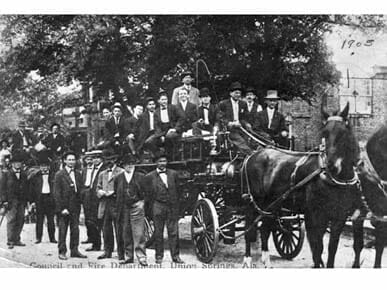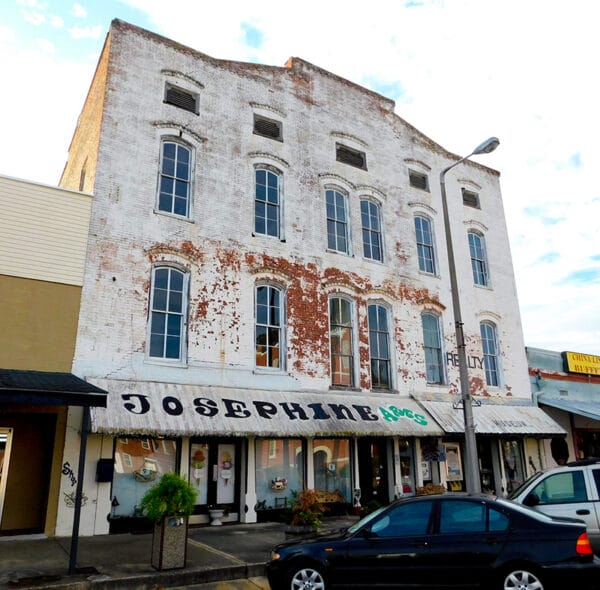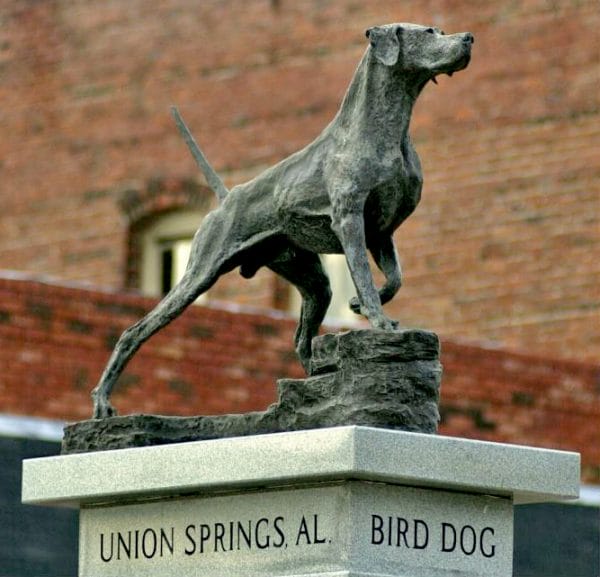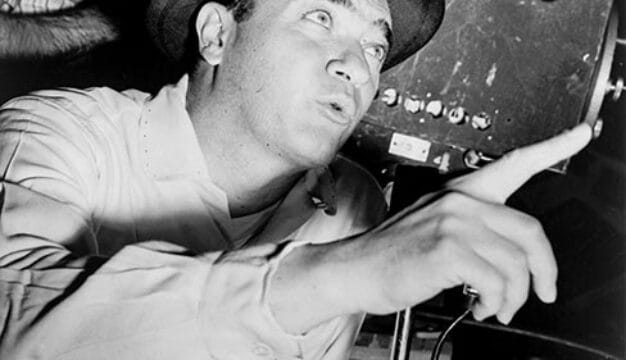Union Springs
 Bird Dog Mural
Union Springs, the county seat of Bullock County, is located in the Black Belt region of eastern Alabama. The first European settlers arrived in the area after the Creek Indian removal of the 1830s and gave the town its name because of the 27 springs flowing from the nearby Chunnenuggee Ridge. The rich black belt soil and ample fresh water of the area attracted migrants from surrounding states and made Union Springs a prosperous antebellum agricultural center. Union Springs was officially incorporated on January 13, 1844, as part of Macon County. When Bullock County was created in 1866 from parts of Macon, Montgomery, Pike, and Barbour Counties, voters chose Union Springs as the county seat. Union Springs has a mayor-council form of government, with the mayor and council members serving four-year terms.
Bird Dog Mural
Union Springs, the county seat of Bullock County, is located in the Black Belt region of eastern Alabama. The first European settlers arrived in the area after the Creek Indian removal of the 1830s and gave the town its name because of the 27 springs flowing from the nearby Chunnenuggee Ridge. The rich black belt soil and ample fresh water of the area attracted migrants from surrounding states and made Union Springs a prosperous antebellum agricultural center. Union Springs was officially incorporated on January 13, 1844, as part of Macon County. When Bullock County was created in 1866 from parts of Macon, Montgomery, Pike, and Barbour Counties, voters chose Union Springs as the county seat. Union Springs has a mayor-council form of government, with the mayor and council members serving four-year terms.
History
 Union Springs, ca. 1905
Originally Creek Indian territory, the rich land of Bullock County made Union Springs an important center of the antebellum cotton trade beginning in the 1830s. With no access to river transport, Union Springs conducted its trade with the market in Columbus, Georgia, via the Mobile and Girard Railway Company. During the antebellum period, cotton barons built many striking mansions along the Chunnenuggee ridge, including the 1843 Moorish Revival style Foster-Chapman House, childhood home to civil rights activist Virginia Foster Durr. Although these homes and much of the town were spared generally from the destruction of the Civil War, the impact of Reconstruction and Emancipation led to a period of post-war economic decline.
Union Springs, ca. 1905
Originally Creek Indian territory, the rich land of Bullock County made Union Springs an important center of the antebellum cotton trade beginning in the 1830s. With no access to river transport, Union Springs conducted its trade with the market in Columbus, Georgia, via the Mobile and Girard Railway Company. During the antebellum period, cotton barons built many striking mansions along the Chunnenuggee ridge, including the 1843 Moorish Revival style Foster-Chapman House, childhood home to civil rights activist Virginia Foster Durr. Although these homes and much of the town were spared generally from the destruction of the Civil War, the impact of Reconstruction and Emancipation led to a period of post-war economic decline.
By 1885, Union Springs had rebounded from the aftermath of the Civil War. The town was by then a junction of the Mobile and Girard and the Montgomery and Eufaula Railroads. It was home to an oil mill, a planing mill, and professional offices for doctors and lawyers. Cotton mills soon followed and again made Union Springs an economic hub for the surrounding counties. The growth of commerce in Union Springs enriched many of its citizens and led to more mansions being built around the town. These buildings and their antebellum predecessors now form the core of Union Springs’s popular Historic District.
 Josephine Hotel
Beginning in the early twentieth century, land originally used for cotton farming in Bullock County began to give way to other uses, particularly hunting. By the 1920s, game preserves occupied many of the sites of former cotton plantations. During that period, Lewis B. Maytag, an avid hunter and originator of the Maytag line of appliances, created a 14,000-acre hunting preserve known as the Sedgefields Plantation. This preserve and the lands surrounding it became a very popular location for bird dog field trials, which continue today. Field trials judge a bird dog’s ability to successfully point out the hiding places of game birds. From its founding through the present day, the economy of Union Springs has remained tied to agriculture. Bonnie Plant Farms, the nation’s largest grower of container vegetables and herbs, was founded in Union Springs and now has facilities in all 50 states.
Josephine Hotel
Beginning in the early twentieth century, land originally used for cotton farming in Bullock County began to give way to other uses, particularly hunting. By the 1920s, game preserves occupied many of the sites of former cotton plantations. During that period, Lewis B. Maytag, an avid hunter and originator of the Maytag line of appliances, created a 14,000-acre hunting preserve known as the Sedgefields Plantation. This preserve and the lands surrounding it became a very popular location for bird dog field trials, which continue today. Field trials judge a bird dog’s ability to successfully point out the hiding places of game birds. From its founding through the present day, the economy of Union Springs has remained tied to agriculture. Bonnie Plant Farms, the nation’s largest grower of container vegetables and herbs, was founded in Union Springs and now has facilities in all 50 states.
Demographics
According to 2020 Census estimates, Union Springs recorded a population of 3,465. Of that number, 77.9 percent identified themselves as black, 19.7 percent as white, 13.9 percent as Hispanic or Latino, and 2.3 percent as Asian. The city’s median household income was $21,422, and per capita income was $15,555.
Employment
According to 2020 Census estimates, the workforce in Union Springs was divided among the following industrial categories:
- Manufacturing (47.7 percent)
- Educational services, and health care and social assistance (14.9 percent)
- Arts, entertainment, recreation, accommodation, and food services (14.4 percent)
- Public administration (9.1 percent)
- Transportation and warehousing and utilities (5.6 percent)
- Retail trade (2.7 percent)
- Information (2.1 percent)
- Agriculture, forestry, fishing and hunting, and extractive (2.0 percent)
- Professional, scientific, and management, and administrative and waste management services (1.4 percent)
- Finance, insurance, and real estate, rental, and leasing (0.1 percent)
Education
Schools in Union Springs are part of the Bullock County school system; the town has two elementary schools and one high school.
Transportation
Two major highways intersect in Union Springs: U.S. Highway 82, an east-west artery, and U.S. Highway 29, a north-south route. Franklin Field, the municipal airport, has a 3,660-foot runway and serves general aviation. Bus service is provided to Union Springs by Greyhound Lines, Inc.
Events and Places of Interest
 The Red Door Theatre
Union Springs’s rich rural and agricultural heritage features largely in the local attractions. The Chunnenuggee Garden, established in 1847, is one of the oldest public gardens in the United States and is the oldest in Alabama. The Chunnenuggee Fair is a modern continuation of a pre-Civil War festival that was originally hosted by the oldest horticultural society in the United States, the Chunnenuggee Garden Club. The National Register of Historic Places lists 47 homes and businesses in Union Springs that have been preserved as standing monuments to the town’s history. In addition to the historic Second Empire Bullock County Courthouse, built in 1872, the Courthouse Historic District has 25 other historic buildings, including antebellum homes and churches, a
The Red Door Theatre
Union Springs’s rich rural and agricultural heritage features largely in the local attractions. The Chunnenuggee Garden, established in 1847, is one of the oldest public gardens in the United States and is the oldest in Alabama. The Chunnenuggee Fair is a modern continuation of a pre-Civil War festival that was originally hosted by the oldest horticultural society in the United States, the Chunnenuggee Garden Club. The National Register of Historic Places lists 47 homes and businesses in Union Springs that have been preserved as standing monuments to the town’s history. In addition to the historic Second Empire Bullock County Courthouse, built in 1872, the Courthouse Historic District has 25 other historic buildings, including antebellum homes and churches, a
 Bird Dog Field Trial Monument
Carnegie Library, and the Red Door Theatre. Union Springs bills itself as the Field Trial Capitol of the World and since 1921 has welcomed hundreds of tourists every February at the National Amateur Free-for-All Championship of field trials. The Bird Dog Field Trial Monument, located in Union Springs’s Courthouse Historic District, is a life-sized bronze statue of a pointer that pays tribute to the 11 men inducted into the Bird Dog Field Trial Hall of Fame.
Bird Dog Field Trial Monument
Carnegie Library, and the Red Door Theatre. Union Springs bills itself as the Field Trial Capitol of the World and since 1921 has welcomed hundreds of tourists every February at the National Amateur Free-for-All Championship of field trials. The Bird Dog Field Trial Monument, located in Union Springs’s Courthouse Historic District, is a life-sized bronze statue of a pointer that pays tribute to the 11 men inducted into the Bird Dog Field Trial Hall of Fame.
Additional Resources
The Heritage of Bullock County, Alabama. Clanton, Ala: Heritage Publishing Consultants, 2004.



